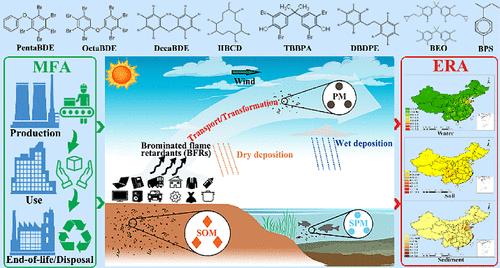当前位置:
X-MOL 学术
›
Environ. Sci. Technol.
›
论文详情
Our official English website, www.x-mol.net, welcomes your feedback! (Note: you will need to create a separate account there.)
Brominated Flame Retardants (BFRs) in China Over the Past Half-Century: Stocks, Flows, Fates, and Ecological Risks
Environmental Science & Technology ( IF 10.8 ) Pub Date : 2024-07-25 , DOI: 10.1021/acs.est.4c00183 Zhihui Chen 1 , Tengyun Ma 1 , Wei Liu 1, 2 , Gang Yuan 3 , Xin Pan 1 , Mingyue Zhang 1 , Xiaoyu Luan 1 , Zhaojie Cui 1 , Jia Xin 4
Environmental Science & Technology ( IF 10.8 ) Pub Date : 2024-07-25 , DOI: 10.1021/acs.est.4c00183 Zhihui Chen 1 , Tengyun Ma 1 , Wei Liu 1, 2 , Gang Yuan 3 , Xin Pan 1 , Mingyue Zhang 1 , Xiaoyu Luan 1 , Zhaojie Cui 1 , Jia Xin 4
Affiliation

|
China is a significant producer and consumer of various brominated flame retardants (BFRs), raising environmental concerns due to their widespread presence and potential threats to ecosystems and organisms. This study adopts a life cycle perspective, combining material flow analysis, multimedia environmental modeling, and ecological risk assessment to systematically analyze the substance metabolism and ecological risks of six BFR types in China from 1970 to 2021. The findings reveal that China’s cumulative BFR consumption reached 3.3 Mt, with the electronics sector being the predominant contributor at 52.1%. Consequently, 1.5 kt of BFRs were released into the environment, with 24.9%, 31.5%, and 43.6% being discharged into the air, water, and soil, respectively. Notably, the proportion of novel BFRs in emissions has steadily increased over the years, exemplified by the increase in decabromodiphenyl ethane (DBDPE) from 21.3% in 2010 to 30.1% in 2021. Geographically, BFR concentrations are higher in the eastern and southwestern regions compared to those in the northwest. Presently, certain BFRs like tetrabromobisphenol A (TBBPA) and DBDPE exhibit moderate to high ecological risks, primarily concentrated in the Shandong and Sichuan provinces. A combination of efficient recycling, emission control, and substitution with novel flame-retardant can minimize the exposure of BFRs to the environment and organisms.
更新日期:2024-07-25












































 京公网安备 11010802027423号
京公网安备 11010802027423号